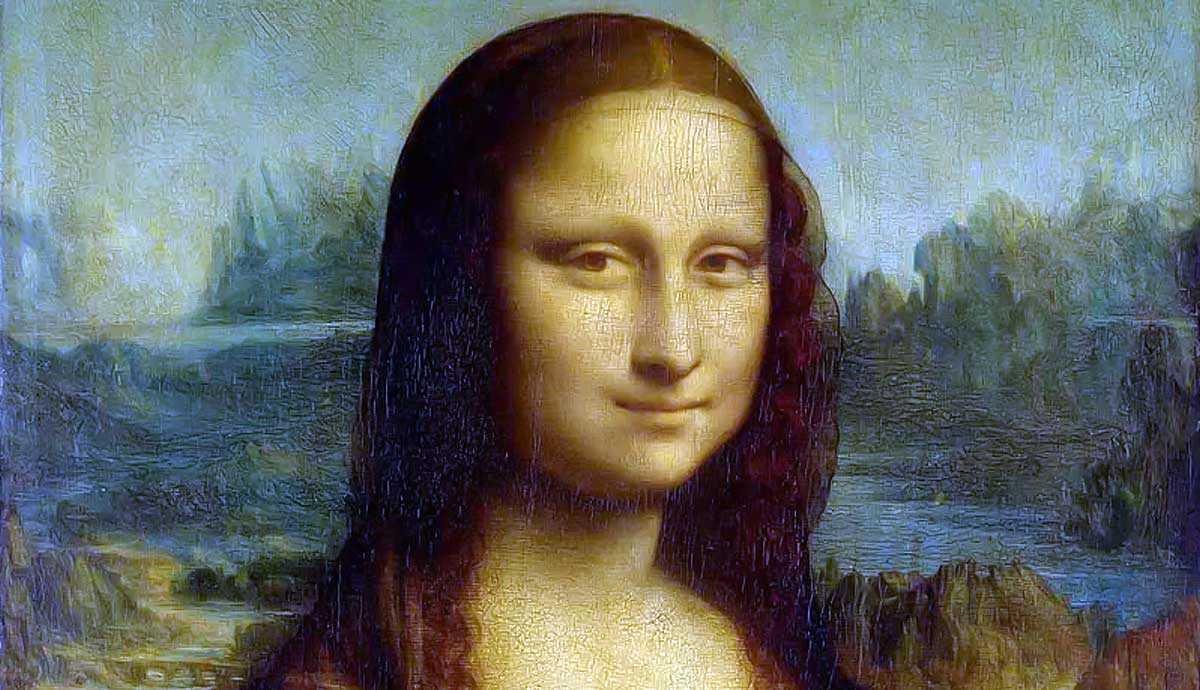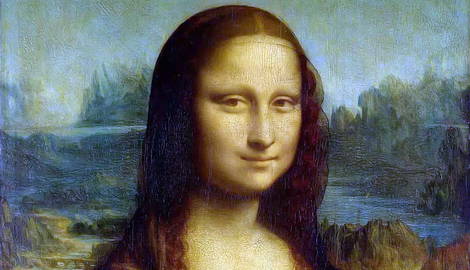
The Mona Lisa is probably the most famous painting in the world. Painted in the 16th century by Leonardo da Vinci, it has an amazing history. Her smile has left a lasting impression on lovers of art and beauty throughout the ages. The Mona Lisa draws thousands of visitors a year to her home in the Louvre in Paris, France, where she lives behind bulletproof glass.
1. Da Vinci Kept the Mona Lisa Until He Died

Is she finished? If so, why doesn’t she have eyebrows? The Mona Lisa, begun in 1503 by the famed painter, scientist, and sculptor Leonardo da Vinci, was never truly “finished.” Da Vinci was a notoriously slow worker, often taking decades to complete a piece, and the Mona Lisa epitomizes this tendency. Later reports show that she had eyebrows and eyelashes that either faded or were erased by da Vinci himself. Whether he ever finished the work will never be known.
Also known as “La Gioconda” (which translates to “the joyful one” in reference to Mona Lisa’s smile), the painting was commissioned in 1503 by Florentine silk merchant Francesco del Giocondo as a portrait of his wife. When Francesco del Giocondo came to collect the painting, Leonardo told him it wasn’t finished! As a result, Del Giocondo never paid da Vinci. When da Vinci moved from Florence, Italy, to France in 1516—after French King Francis I conquered Northern Italy—he took the Mona Lisa with him to continue working on it.
Da Vinci reportedly worked for the king until an arm injury, likely caused by a stroke, left him unable to paint after 1517. He died in 1519. Either da Vinci himself or the executors of his estate sold the Mona Lisa to King Francis I for 4,000 gold ducats, equivalent to approximately £600,000 in today’s money. Francis I wasn’t the only French royal to admire the Mona Lisa—Napoleon Bonaparte reportedly kept her in his bedroom.
2. The Mona Lisa Was Widely Forged

The painting remained in France after being purchased by King Francis I until… On August 22, 1911, as national tensions rose and Europe edged closer to war, a young Italian man named Vincenzo Peruggia decided the painting by the Italian master belonged in Italy.
In one of history’s first and most daring art thefts, Peruggia broke into the Louvre and stole La Gioconda. After two years of searching—and several false arrests, including one of Picasso—the Mona Lisa was finally recovered on December 29, 1913. A gallerist had grown suspicious of a painting offered to him, recognizing a stamp on its back. His instincts proved correct—or at least, so we believe.

There’s another story, reported by journalist Karl Decker, which claims that a gang forged and sold copies of the Mona Lisa across the world during the two years it was missing. According to Decker, a man who called himself the Marquis of the Vale of Hell orchestrated the theft and the sale of these forgeries, with each buyer believing they were purchasing the real Mona Lisa. However, this report has been hotly disputed, and Decker was accused of fabricating the entire tale.
Regardless of the controversy, it was this theft that propelled the Mona Lisa into the stratosphere, cementing its status as the most famous painting on Earth. While it was already well-loved and respected in art circles, it was the theft that truly catapulted the Mona Lisa into the public consciousness. As the most famous painting in the world, it would go on to have a whole new chapter nearly 30 years later.
In 1939, the Nazis, under the guidance of Adolf Hitler, invaded Poland. As part of their plan, they sought to collect world heritage items, including art, and went throughout Europe, looting and pillaging cultural artifacts. The Mona Lisa was high on their list. In an incredible twist, the Louvre took action to deceive the Nazis. They created forgeries of La Gioconda and strategically placed them throughout castles in France, pretending each one was the genuine painting. This clever ruse helped protect the real Mona Lisa from falling into Nazi hands.

An American group called the Monuments Men was tasked with recovering cultural artifacts stolen by the Nazis during World War II. In one of the treasure troves that Hitler had stashed away—intended for future museums to display his plunder—they discovered a box labeled “Mona Lisa from Paris.” Fortunately, the Louvre’s ruse had worked. The painting in the box was not the original Mona Lisa. In reality, the Louvre had moved the painting multiple times during the war to keep it hidden. The real Mona Lisa was safely protected, and she triumphantly returned to Paris on June 16, 1945.
3. The Mona Lisa Was Attacked by Protesters

Since returning from the war, La Gioconda has led a mostly peaceful life—until recently, that is. A group of climate activists called “Just Stop Oil,” along with other similar groups, has gained attention for its extreme tactics. From blocking motorways to shutting down airport runways, its actions span a wide range of protest methods. The tactic that has likely garnered the most media coverage, however, consists of attacks on major works of art. With over 38 attacks on artworks since 2021, the Mona Lisa—being the most famous painting in the world—was, of course, a prime target.
And our fine, smiling lady has been attacked twice now. The first incident occurred on May 29, 2022, when a man disguised as an elderly woman smeared cake on the glass covering the painting while shouting about protecting the planet. He was quickly removed, and the painting remained unharmed. Then again, in January 2024, two climate protesters threw cans of tomato soup at the painting and shouted in protest. They, too, were swiftly removed, and the Mona Lisa remained unharmed. Today, the painting is safely behind bulletproof glass in a climate-controlled environment. While the protesters never had a chance to damage the artwork, their actions are undoubtedly an effective way to draw attention to their cause.
4. She Inspires Pop Culture

The most famous painting in the world seems to get plenty of attention. From books to movies to other artists copying her, La Gioconda seems to show up repeatedly in popular culture. The entire first section of Dan Brown’s book The Da Vinci Code is focused on La Gionconda’s beautiful smile. More recent credits include the movie Glass Onion, where the main villain has the Mona Lisa in his personal residence where it is destroyed in a devastating fire.
5. It Inspired Artists

Not long after da Vinci unveiled the Mona Lisa, other sitters began to pose with smiles and arms crossed in front of their laps. More importantly, da Vinci is credited with inventing what we think of as the modern portrait. While the Mona Lisa was not the first portrait of this style that da Vinci produced, it marked a significant evolution in portraiture. The work shown above is Lady with an Ermine (1489), painted by da Vinci, which showcases the early signs of the stylistic elements that would later define the Mona Lisa and influence portraits for generations.

The Mona Lisa’s smile has also left a significant mark on the arts. Marcel Duchamp, the king of ready-mades, famously used the Mona Lisa as inspiration. He took a postcard of the famous lady and added a mustache, reworking the image with a new title. He is not the only ultra-famous artist to give a nod to the lady. Andy Warhol’s iconic silk screen print with her face in multiple different colors took the art world by storm.
6. It Is Worth a Lot of Money

Imagine going back in time and asking da Vinci what he thought he would be most remembered for in his lifetime. Did he keep the Mona Lisa because he loved her or because he believed she wasn’t good enough to share? His journals offer no clear answer. What we do know is that he often expressed doubt about his own abilities. The drive to improve is evident in all of his journal entries.
While he primarily earned his living through painting commissions, da Vinci was also commissioned to design war machines, create scientific instruments, and develop journals that would later inspire the Wright brothers in their pursuit of flight. His scientific journals, known as the Codex Leicester, were purchased by billionaire entrepreneur Bill Gates in 1994 for a staggering $30 million—equivalent to roughly $70 million in 2024. Clearly, da Vinci’s work remains incredibly valuable!
Yet the Codex Leicester is nothing compared to the value of the Mona Lisa. Widely considered priceless, the painting is insured by the nation of France itself, as no third-party insurer is willing to risk the value assigned to this national treasure. At its last evaluation, the artwork was estimated to be worth roughly $1 billion. This makes the Mona Lisa by far the most valuable artwork ever created.
Some experts even suggest that if the Mona Lisa were ever auctioned, it could fetch well over $1 billion. For comparison, a da Vinci masterpiece, Salvator Mundi, was sold at auction in 2017 for $450 million by Christie’s. In fact, one tech entrepreneur even proposed that France auction off the Mona Lisa to other countries for 50 billion Euros to help pay off the national debt. Once a year, the painting is carefully taken down and inspected.
7. The Mona Lisa Carries Hidden Meanings

Another secret of the Mona Lisa is that there is another painting underneath. Understanding the artist’s process can help us gain deeper insights into why this masterpiece has become the most valuable and famous painting in the world. It wasn’t until the end of 2015 that this hidden portrait was discovered. Using cutting-edge reflective light technology, researchers were able to uncover a second layer of paint beneath the surface, revealing another image underneath the iconic Mona Lisa.

This isn’t the only hidden secret behind the Mona Lisa’s smile. For a taste of some of the major conspiracy theories, check out Dan Brown’s thrilling novel, The Da Vinci Code. For something more straightforward, the Mona Lisa is a perfect example of the use of the golden ratio. This is a mathematical ratio where the sum of the two smaller parts equals the larger part, and it recurs throughout nature in various natural formations.








